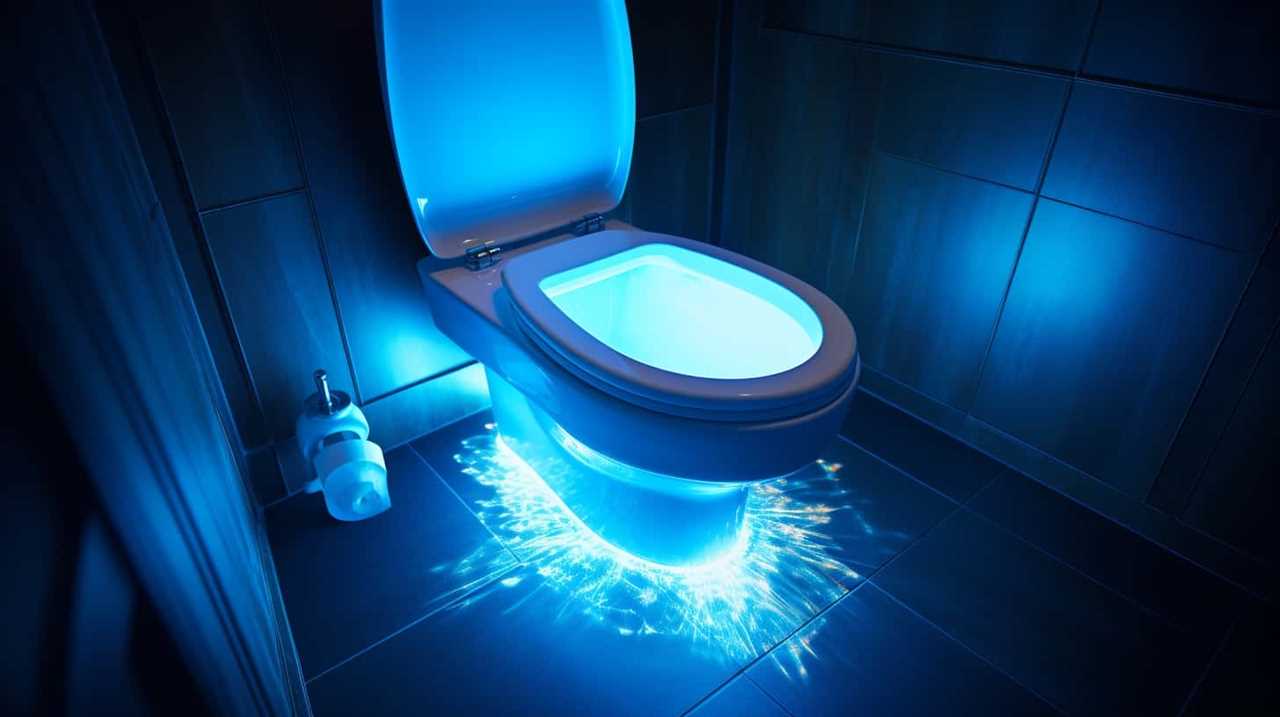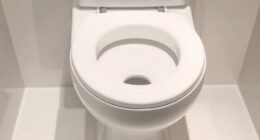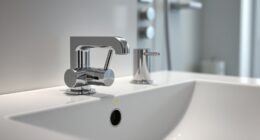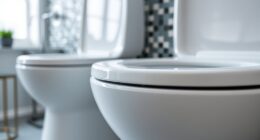Are there various types of toilet flush buttons?
Well, you’re in luck! We’re here to shed light on the different options available to you.
From the traditional push buttons to the futuristic motion-sensor activated flush buttons, we’ll explore the wide range of choices in this article.
So, if you’re eager to master your toilet’s flushing mechanism and upgrade your bathroom experience, keep reading to discover the diverse world of toilet flush buttons.

Key Takeaways
- Traditional flush buttons are familiar, easy to use, and common in households and public restrooms.
- Water-efficient flush buttons, such as dual flush buttons, offer the option to choose between full flush and half flush, reducing water usage and saving on water bills.
- Hygienic flush buttons, like sensory touch buttons or remote-controlled buttons, promote better hygiene and are convenient for individuals with limited dexterity or mobility.
- Motion-sensor activated flush buttons are more hygienic, conserve water through sensor detection, and have an energy-efficient operation on battery power. However, they have a higher cost and occasional maintenance is required.
Traditional Push Buttons
We prefer using traditional push buttons for toilet flushes as they’re familiar and easy to use. Traditional push buttons are one of the most common toilet flush mechanisms found in households and public restrooms. They consist of a single button that’s pressed to initiate the flushing process.
One of the main pros of traditional push buttons is their simplicity. Users are accustomed to this mechanism and find it intuitive to operate. Additionally, traditional push buttons are generally reliable and require minimal maintenance.
However, there are some cons to consider. These buttons may require more force to press, which can be a concern for individuals with limited strength or mobility. Furthermore, traditional push buttons usually offer a single flush volume, which may not be as water-efficient as other options.
Transitioning to the subsequent section, let’s now explore the advantages of dual flush buttons.

Dual Flush Buttons
Moving on to the next type of toilet flush buttons, dual flush buttons offer a more water-efficient option compared to traditional push buttons. These buttons are a part of water-saving technology, allowing users to choose between a full flush and a half flush, depending on the waste being disposed of. The benefits of dual flush buttons are evident in the table below:
| Benefits | Drawbacks |
|---|---|
| Reduces water usage | Higher initial cost |
| Saves on water bills | Requires more frequent cleaning |
| Environmentally friendly | Limited design options |
Dual flush buttons provide the option to conserve water by using less for liquid waste and more for solid waste. This not only helps in reducing water bills but also contributes to a sustainable environment. However, it is important to note that dual flush buttons may have a higher initial cost and require more frequent cleaning compared to traditional push buttons. Additionally, the design options for dual flush buttons may be limited. Nevertheless, the water-saving benefits make dual flush buttons an attractive choice for those seeking a more eco-friendly and cost-effective toilet flushing solution.
Sensory Touch Buttons
Now let’s explore another type of toilet flush buttons: how do sensory touch buttons enhance the flushing experience?
Sensory touch buttons, also known as touch-sensitive buttons, offer several hygiene benefits and ease of use. These buttons are designed to respond to the touch of a finger, eliminating the need for physical contact with the flush mechanism. This reduces the spread of germs and bacteria, promoting better hygiene in the bathroom.

Additionally, sensory touch buttons are easy to operate for people of all ages and abilities. They provide a simple and intuitive interface, requiring only a gentle touch to activate the flush. This makes them particularly convenient for individuals with limited dexterity or mobility.
Remote-Controlled Flush Buttons
Continuing our exploration of different types of toilet flush buttons, let’s now delve into the realm of remote-controlled flush buttons. With the smart technology advancements in recent years, it’s no surprise that even our toilets are becoming more high-tech. Remote-controlled flush buttons offer a convenient and hygienic solution for flushing, eliminating the need for physical contact with the button. These buttons can be operated from a distance, allowing users to flush the toilet without having to reach for the traditional lever or push-button.
Here is a table highlighting some of the benefits of remote-controlled flush buttons:
| Benefits |
|---|
| 1. Hygienic |
| 2. Convenient |
| 3. Easy to use |
| 4. Customizable |
| 5. Suitable for people with mobility issues |
Motion-Sensor Activated Flush Buttons
Exploring the realm of toilet flush buttons, we now turn our attention to motion-sensor activated flush buttons. These technologically advanced buttons offer several advantages over traditional push buttons:

- Convenience: Motion sensor activated flush buttons eliminate the need for physical contact, providing a more hygienic experience.
- Water conservation: These buttons are equipped with sensors that detect the user’s presence and adjust the flush accordingly, leading to water savings.
- Energy efficiency: Motion-sensor activated flush buttons operate on battery power, ensuring minimal energy consumption.
- Durability: With no physical buttons to wear out or break, motion sensor activated flush buttons tend to have a longer lifespan.
However, there are a few disadvantages to consider:
- Cost: Motion-sensor activated flush buttons are generally more expensive than traditional push buttons.
- Maintenance: The sensors may require occasional cleaning and calibration to maintain optimal performance.
When comparing motion sensor activated flush buttons to traditional push buttons, it’s clear that the former offers superior hygiene, water conservation, and energy efficiency. However, the higher cost and maintenance requirements are factors to consider.
Frequently Asked Questions
How Do Traditional Push Buttons Work?
Traditional push buttons work by activating the toilet flush mechanism when pressed. The button is connected to a lever inside the tank, which lifts the flapper or releases water directly into the bowl, depending on the design.
What Are the Advantages of Using Dual Flush Buttons?
Using dual flush buttons has many advantages, like their effectiveness in conserving water. They allow us to control the amount of water used, reducing waste and promoting sustainability.
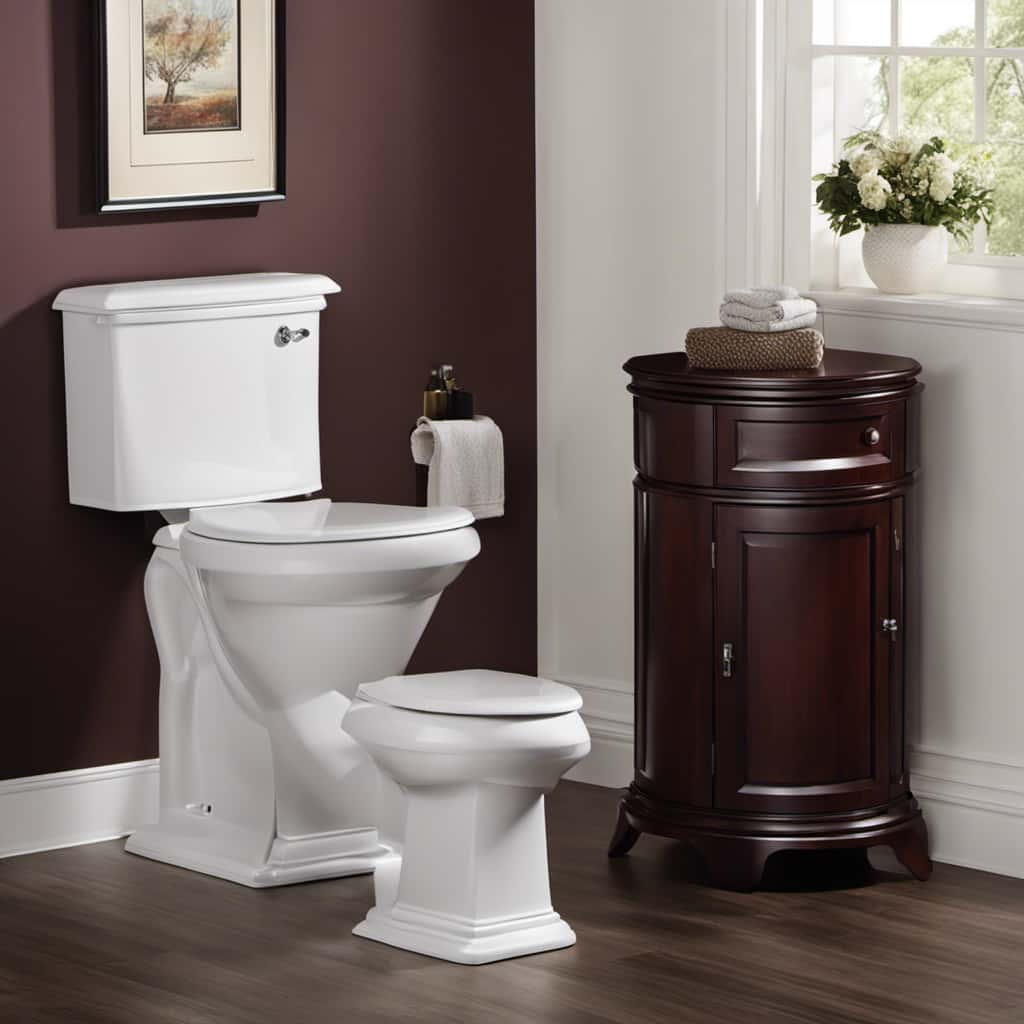
Are There Any Additional Features Available on Sensory Touch Buttons?
There are additional features available on sensory touch buttons, which offer benefits such as improved hygiene and convenience. When compared to push buttons, touchless flush buttons provide a more advanced and user-friendly experience.
How Does the Remote-Controlled Flush Button Function?
Remote-controlled flush buttons function by using advanced technology to activate the flushing mechanism. This innovation allows for precise control and customization of the flushing process. Additionally, these buttons have a positive impact on water conservation efforts.
Can Motion-Sensor Activated Flush Buttons Be Adjusted for Sensitivity?
Adjusting motion sensor sensitivity on flush buttons can be done to ensure proper function. Troubleshooting tips include checking battery life, ensuring proper installation, and adjusting range or angle for optimal detection.
Conclusion
In conclusion, it’s fascinating how something as simple as a toilet flush button can come in various types. From the traditional push buttons to the high-tech motion-sensor activated ones, there’s a wide range of options available.

These different types cater to different preferences and needs, providing convenience and efficiency in the bathroom. Whether you prefer a hands-on approach or a touch-free experience, there’s a toilet flush button out there for everyone.
